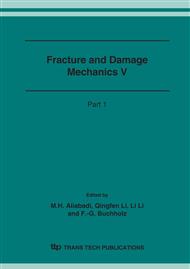p.1039
p.1043
p.1047
p.1051
p.1055
p.1059
p.1063
p.1067
p.1071
Behavior and Fracture Mechanism of Brittle Rock with Pre-Existing Parallel Cracks
Abstract:
There is a macro-crack and micro-crack system in rock, which affects almost all the mechanical properties of rock, especially for the fracture mechanism. The propagation of pre-existing cracks in rock samples under load is fundamental to understanding of rock fracture mechanisms. It is evident that assumption of Griffith theory was not in accord with the fact that numerous cracks exist in rock. So, it is difficult to explain how the propagation of a micro-crack developed into macro-failure by conventional theories. In order to investigate the cause and results of fracture within the rock, the stress concentration around the micro-cracks was analyzed, which resulted in propagation of wing cracks and connecting adjacent original cracks, eventually leading to macro-failure. The experiments on gypseous samples with pre-existing parallel cracks (flat rectangular in shape) under compression were carried out. The fracture mechanism and the stress equilibrium condition at brittle rock were discussed. Based on the fracture mechanism of brittle rock, a strength criterion of rock was proposed.
Info:
Periodical:
Pages:
1055-1058
Citation:
Online since:
November 2006
Authors:
Keywords:
Price:
Сopyright:
© 2006 Trans Tech Publications Ltd. All Rights Reserved
Share:
Citation:


